Gemstone Bottles: A Comprehensive Insight
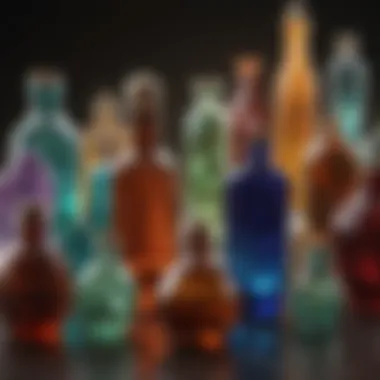
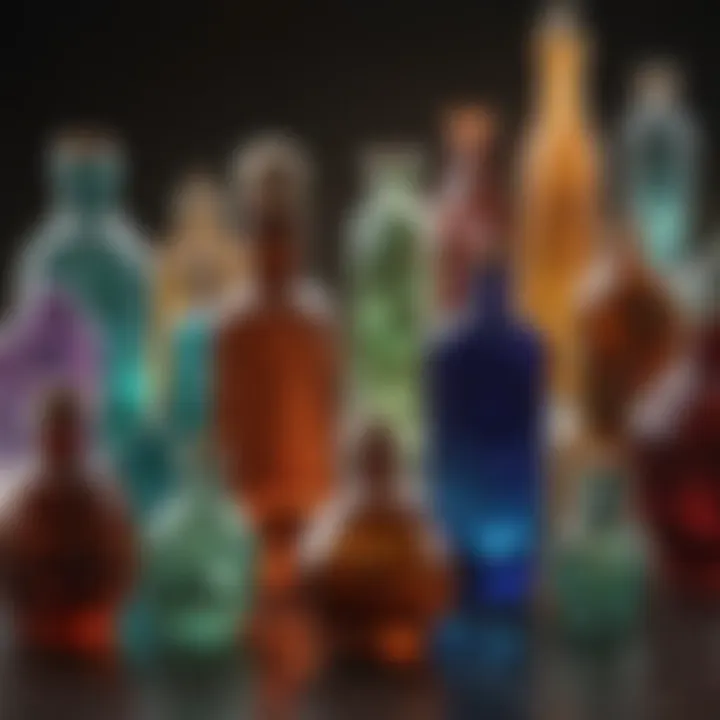
Intro
Gemstone bottles have captivated collectors and enthusiasts for centuries. Their appeal lies not only in their aesthetic beauty but also in the stories they tell about human culture and geological history. From ancient civilizations that utilized these beautiful artifacts for storage to modern collectors who appreciate their craftsmanship, gemstone bottles are more than just decorative items—they are vessels of history.
In this exploration, we will delve into the historical significance of gemstone bottles, the intricate techniques involved in their crafting, and the various types of gemstones commonly used. We will also provide valuable insights into the process of evaluating and collecting these unique pieces, appealing to both seasoned collectors and newcomers alike.
As we progress, you will gain a deeper understanding of the geological properties of the gemstones used and how they contribute to the significance of these captivating bottles.
Prelims to Gemstone Bottles
Gemstone bottles represent a unique intersection of art, science, and culture. They have captured the interest of collectors and enthusiasts for centuries. Understanding these artifacts is essential for anyone interested in geology, craftsmanship, or historical artifacts. In this section, we will explore the definition of gemstone bottles and delve into their historical context and evolution. This investigation not only highlights their significance but also reflects on how they have shaped and been shaped by human history.
Defining Gemstone Bottles
Gemstone bottles are containers made from various types of gemstones, crafted or carved to hold liquids. They serve both practical and decorative functions. In essence, the materials used define their aesthetic and functional qualities. Common choices for these bottles include amethyst, citrine, jade, and agate. Each gemstone brings unique physical and chemical properties, influencing the bottle's appearance and durability.
The artistry involved in creating these bottles adds another layer of definition. The craftsmanship can vary significantly, from simple structures to intricate designs that showcase the skill of the artisan. The intent behind these creations also holds weight; they may serve as ceremonial vessels, personal adornments, or components of herbal medicine.
Historical Context and Evolution
The history of gemstone bottles can be traced back to ancient civilizations. Early cultures utilized them not just for practical storage but also in spiritual and medicinal contexts. For example, the Egyptians created beautiful alabaster vials to hold oils and perfumes. These items were often buried with the dead, suggesting a belief in their significance beyond earthly life.
As time passed, the crafting of gemstone bottles evolved. In the East, during the Ming and Qing dynasties, these bottles became highly prized, often elaborately painted and fitted with stoppers. They served as symbols of wealth and refinement. In Western societies, gemstone bottles also gained prominence in the 17th and 18th centuries, becoming fashionable collectibles.
The demand for these bottles has fluctuated through history, influenced by changing tastes and the availability of gemstones. Today, they appeal to both collectors and casual admirers, standing as evidence of the enduring allure of natural beauty and human craftsmanship. Their history provides insights into the social and cultural dynamics of the times during which they were made, will connect collectors with the rich narratives they carry.
Types of Gemstones Used in Bottles
Understanding the types of gemstones used in bottles is essential in appreciating their significance. The choice of gemstone not only impacts the aesthetic appeal but also affects the perceived value and cultural symbolism associated with the bottle. Gemstones can be classified as either precious or semi-precious. This classification influences pricing, availability, and desirability among collectors.
Precious vs Semi-Precious Gemstones
Precious gemstones include diamonds, rubies, sapphires, and emeralds. These stones are rare and often more expensive. Their brilliance, color, and clarity make them highly sought after for bottles. Semi-precious gemstones, such as amethyst, citrine, and jade, are more common and accessible to a broader audience. While they may lack the high status of precious stones, they offer unique beauty and can carry significant cultural or metaphysical meanings.
Choosing between a precious and a semi-precious gemstone depends largely on the collector's intention and budget. Precious stones might be seen as better investments due to their rarity, while semi-precious stones are often valued for their variety and availability.
Common Gemstones in Bottles
- Amethyst: Amethyst is known for its deep purple hue. This stone draws an audience for its association with tranquility and clarity of mind. Its availability and stunning color make it a popular choice for decorative bottles. Amethyst is relatively durable, making it practical for use, although it may fade if exposed to intense sunlight over time.
- Citrine: Citrine is commonly recognized for its warm yellow color, often linked to optimism and energy. Its bright hue adds vibrant flair to any bottle, making it a favorable choice for collectors. Unlike amethyst, citrine does not lose its color in sunlight, enhancing its usefulness in decorative applications.
- Jade: Known for its desirable green tones, jade represents purity and balance in many cultures. Jade bottles have historical significance, particularly in East Asian art. The unique patterns and color variations in jade can be captivating and offer a distinct aesthetic. It is a tougher choice for functional bottles, as it can be prone to scratching.
- Agate: Agate features unique banding patterns that make every piece one-of-a-kind. It is favored for its decorative qualities and resilience. Agate can fit well into both casual and formal settings. Its popularity comes with the advantage of being a hard stone that withstands wear, although its weight can be a disadvantage for portable uses.
- Quartz: Quartz is highly versatile and available in many colors and forms. It represents clarity and stability. Quartz bottles can frequently be found due to their accessibility. However, some quartz varieties may be more fragile than denser stones, which can lessen their practicality for liquid storage, depending on the craft.
Rarer Gemstones and Their Appeal
Rarer gemstones often captivate collectors due to their exclusivity. These stones may include tourmaline, alexandrite, and high-quality garnet. Their limited availability makes them highly valuable. Collectors often view these unique pieces as status symbols while recognizing their aesthetic merits. However, the higher price points and frangibility of these stones should be factored into any buying decision.
Manufacturing Techniques of Gemstone Bottles
The manufacturing of gemstone bottles involves various intricate techniques that significantly influence their final appearance and quality. Understanding these processes is crucial for collectors and enthusiasts. It informs them not only about the value of the bottles but also about the craftsmanship that goes into each one. The way gemstones are mined, cut, polished, and designed can determine the uniqueness and desirability of each bottle.
Mining and Sourcing Gemstones
Gemstones used in bottles are sourced from specific locations around the world. The mining process plays a vital role. Gem hunters venture into various terrains, including mountains and riverbeds. The geographical settings influence the characteristics of the gemstones. For example, amethyst often comes from Brazil or Uruguay, while jade is typically sourced from Myanmar or Canada.
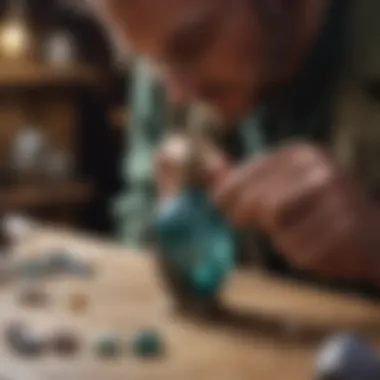
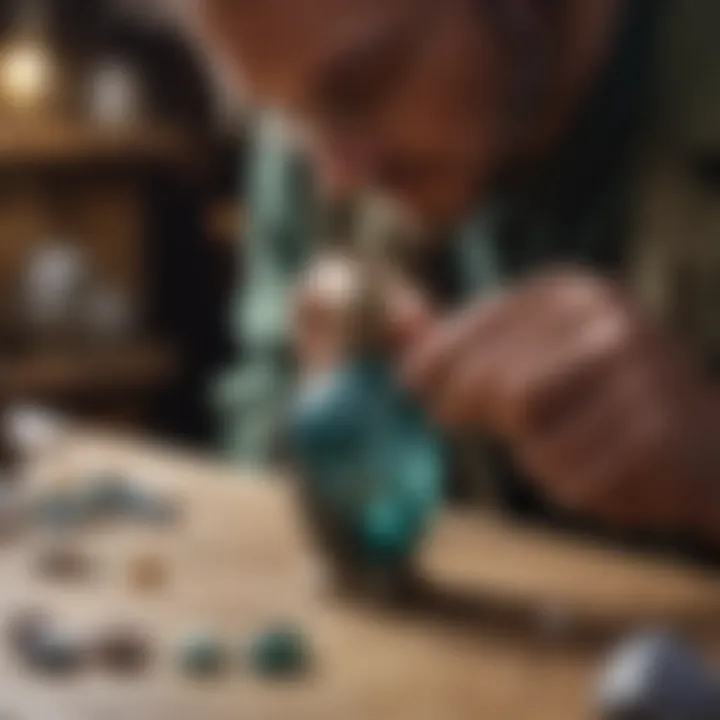
The ethical implications of mining cannot be overlooked. Responsible mining ensures that the gemstones are not only high quality but also sourced in a sustainable manner. Moreover, provenance matters. Knowing the origin of a gemstone can enhance its allure and market value. Collectors look for transparency in the sourcing process. This allows them to feel confident about their purchases and contributes to responsible consumerism.
Cutting and Polishing
The precision of cutting and polishing is what sets apart an ordinary gemstone bottle from an extraordinary one. This step involves skilled artisans who specialize in gem cutting. Each gemstone requires a tailored approach depending on its hardness and inclusions. For instance, softer stones like quartz can be shaped more easily, while harder gemstones, such as sapphire, need advanced techniques.
Polishing is equally crucial. It enhances the gem’s brilliance and color while ensuring that the surface is smooth and reflective. Different methods, such as hand polishing or machine polishing, can be employed based on the desired finish. Artisans take great care to preserve the natural beauty of the gemstone. A well-polished bottle showcases vibrant colors and patterns, making it more attractive to collectors.
Design and Craftsmanship
Designing gemstone bottles is a blend of art and utility. Craftsmanship defines the style and functionality, giving each piece its distinctive look. Designers often draw inspiration from various cultures, which can influence shapes, sizes, and decorative elements. Traditional designs might incorporate intricate carvings, while modern designs may embrace minimalism.
The craftsmanship extends beyond just the aesthetics. Ensuring that the bottle is functional while maintaining visual appeal is a challenge. The mouth of the bottle, cap fittings, and overall balance must be thoughtfully designed to facilitate practical use.
Importantly, the relationship between creator and gemstone is paramount. The artisan’s connection with the material can heavily influence how the piece turns out. A gem that is treated with respect and artistry tends to resonate more with collectors.
"Each gemstone bottle is not just a vessel but a narrative woven through labor, tradition, and creativity."
By understanding manufacturing techniques, collectors can appreciate the values embedded in gemstone bottles, fostering a stronger bond with these unique artifacts.
Cultural Significance of Gemstone Bottles
The cultural importance of gemstone bottles is multifaceted. These artifacts are steeped in history and meaning, attributed to values and beliefs across various societies. Gemstone bottles are not merely decorative or functional objects; they carry messages that transcend time. Their significance spans symbolism, mythology, and artistry, making them an intriguing study for both collectors and scholars.
Symbolism in Different Cultures
In numerous cultures, gemstones represent specific properties or ideals. For example, many ancient societies believed that certain stones could safeguard against misfortune or promote prosperity. Jade, particularly in Chinese culture, is associated with purity and moral integrity. Many would use jade bottles for storage, as they believed the stone could enhance the liquid's qualities, offering both protection and enhancement.
Similarly, lapis lazuli has deep historical roots in the Middle East and Egypt. This richly blue stone symbolizes the heavens and the divine. Bottles carved from lapis lazuli were often used in sacred practices, believed to enhance communication with the spiritual realm. Each culture imbueds its gemstones with unique attributes, which enhances their value beyond the aesthetic.
On the other hand, in Western traditions, gemstones have recently gained attention as symbols of personal milestones and achievements. A unique bottle made of a gemstone can signify a special occasion or serve as a cherished heirloom. The transition from purely functional to symbolic use showcases the evolving role of gemstone bottles in society.
“The beauty and mystique of gemstone bottles offer more than mere aesthetics; they embody rich narratives that define cultural identity.”
Gemstone Bottles in Art and Literature
Gemstone bottles have also appeared in various art forms, showcasing the deep-rooted cultural significance. They often serve as subjects or motifs in paintings, highlighting the beauty and mystery associated with gemstones. The exquisite craftsmanship required to create these bottles draws attention to the artisans' skills and their cultural heritage.
In literature, gemstone bottles frequently symbolize desire, temptation, or the unattainable. They appear in tales where characters seek powerful elixirs or romantic treasures contained within these beautiful containers. Fictional narratives commonly use gemstone bottles to represent the intersection of the mundane and the extraordinary. They hint at hidden truths or magical qualities embedded within.
Moreover, the growing interest in gemstone bottles within modern art reflects their timeless allure. Contemporary artists often use reclaimed gemstone bottles to create new work, merging history with modern viewpoints. These pieces can invoke a sense of nostalgia while also appealing to contemporary aesthetics.
The cultural significance of gemstone bottles is thus a rich tapestry of history, symbolism, and art, reflecting diverse perspectives and practices that endure through the ages. Understanding these dimensions adds depth to collecting and appreciating gemstone bottles while enabling collectors to recognize the stories behind each piece.
Practical Uses of Gemstone Bottles
Gemstone bottles serve both practical and aesthetic purposes, making them intriguing items for collectors and enthusiasts. Understanding their utility enriches the appreciation of their craftsmanship and their connection to history. These bottles are not merely decorative; they have functional roles that can enhance daily life or serve as conversation starters in various settings.
Storage for Oils and Liquids
One of the primary uses of gemstone bottles is for the storage of oils and other liquids. Their non-porous surfaces can help preserve the integrity of essential oils, perfumes, and other liquid substances. Gemstones like amethyst and citrine are believed to impart unique properties to the liquids held within, which adds an extra layer of significance for users.
- Benefits of Using Gemstone Bottles:


- Preservation: The natural properties of certain gemstones can help maintain the quality of oils over time.
- Aesthetic Appeal: Unlike conventional storage containers, gemstone bottles offer an elegant appearance that enhances the ambience of a room.
- Therapeutic Qualities: Some users believe that the vibrations or energies of gemstones may influence the properties of the stored contents.
Considerations for proper use include ensuring the bottle is sealed tightly. Certain oils may react with various materials, so it is wise to research the compatibility of the gemstone with the liquid. For instance, while quartz is generally non-reactive, some fossilized materials might not preserve oils due to their composition.
Decorative Uses in Home and Office
Both in home and office settings, gemstone bottles offer substantial decorative utility. They can be positioned on shelves, desks, or tables to add an element of luxury and sophistication to the surroundings. Likewise, their unique colors and designs can complement various decorative themes, from minimalistic to bohemian styles.
- Using Gemstone Bottles Decoratively:
- Color Coordination: Select bottles that match or contrast well with the existing decor.
- Thematic Arrangements: For a natural theme, group gemstone bottles with plants or crystals.
- Light Reflects: Placing them where they can catch light enhances their aesthetic appeal as well as visual interest.
Beyond aesthetics, these bottles can also serve as conversation pieces, inspiring discussions about their history or the metaphysical qualities attributed to the gemstones. They invite curiosity and connect people through shared interests in geology, art, and craftsmanship.
"The beauty of gemstone bottles lies not only in their appearance but also in the stories and traditions they embody."
In summary, gemstone bottles are versatile items that seamlessly blend functionality with aesthetics. They allow users to express personal style while enjoying practical benefits, making them worthy additions to any collection.
Collecting Gemstone Bottles
Collecting gemstone bottles represents a unique intersection of art, geology, and history. For enthusiasts and collectors, these artifacts are not merely decorative items but are also windows into the past and reflections of cultural significance. Collectors often seek to understand the intricacies behind each bottle—their materials, craftsmanship, and historical context, which can significantly enhance their appreciation.
Criteria for Evaluation
Evaluating gemstone bottles involves discerning several key factors, each contributing to the overall value and desirability of a piece.
Authenticity
Authenticity stands as one of the most important criteria in the evaluation of gemstone bottles. A genuine bottle can hold significant value not only in a monetary sense but also in terms of historical significance. The key characteristic of authenticity lies in the origin and verification of the piece. Collectors benefit immensely from ensuring a bottle is genuine, as it provides peace of mind regarding their investment.
Unique features that contribute to authenticity include documentation from reputable sources and the presence of expert appraisal statements. However, acquiring authenticated pieces can be more challenging and often requires a deeper understanding of the market.
Condition
Condition is another vital aspect that influences the value of gemstone bottles. The overall state of a bottle can indicate its age, usage, and care and can either elevate or detract from its value. A piece in excellent condition is more desirable to collectors because it often signifies that the bottle has been well-preserved over time.
Unique features of a good condition include the absence of chips, cracks, or discoloration, which can detract from the visual appeal and integrity of the bottle. However, some collectors may favor pieces with signs of age as they may contribute to the historical narrative.
Provenance
Provenance refers to the history of ownership of a gemstone bottle. Knowing a bottle's history can not only enhance its value but also offer fascinating stories that connect collectors to history. A well-documented provenance can be a strong indication of the authenticity and rarity of a piece.
The unique aspect of provenance is that it often includes details about previous owners, the circumstances under which the bottle was crafted, and significant events tied to it. This information can add a rich layer of context to the collection, appealing to serious collectors.
Building a Personal Collection
Building a personal collection of gemstone bottles is an engaging process that combines diligent research, patience, and passion. To begin, collectors should establish a clear focus or theme for their collection, which may include specific types of gemstones, shapes, or historical periods. This focus will guide purchasing decisions and help in building a cohesive collection.
Next, it is essential to develop a network of sources. Reputable dealers, auctions, and online platforms can offer excellent opportunities to find unique pieces. Engaging with other collectors can provide valuable insights and tips for obtaining quality items.
Finally, documenting each piece in the collection is crucial. Keeping detailed notes about each bottle's origin, condition, and other pertinent details not only aids in future evaluations but also enhances the overall experience of collecting.
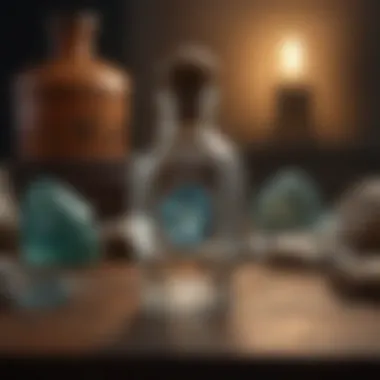
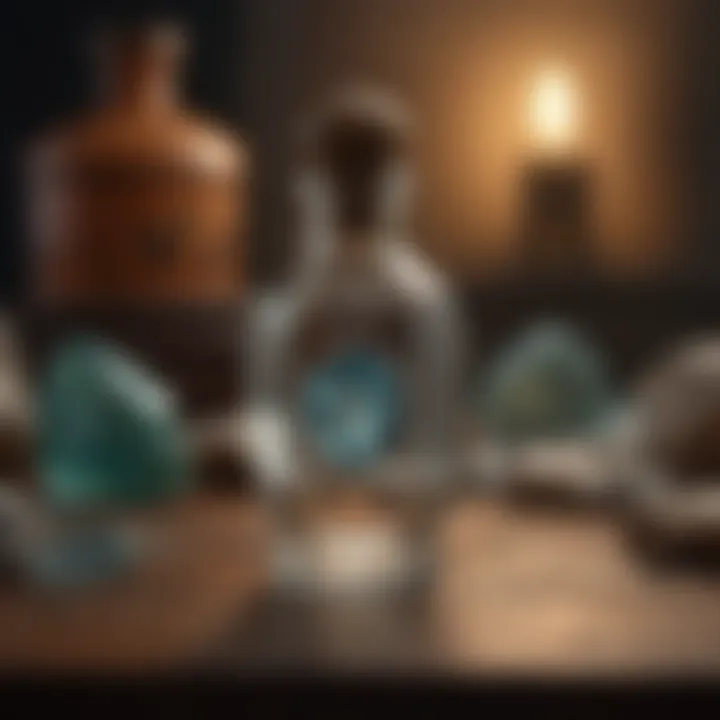
Preservation and Care of Gemstone Bottles
Preserving gemstone bottles is essential for maintaining their beauty and value. Proper care not only enhances their appearance but also ensures their longevity, allowing future generations to appreciate these unique artifacts. Collectors, in particular, should understand that each gemstone bottle they possess may tell a story of creation, culture, or history. Therefore, the attention given to preservation directly impacts the overall appreciation and value of these objects.
Cleaning Techniques
Keeping gemstone bottles clean is critical. Dirt and residue can accumulate and obscure the beauty of the stone. Here are some effective techniques for cleaning:
- Gentle Dusting: A soft, dry microfiber cloth works well for removing dust. This should be done regularly.
- Using Water: For more stubborn marks, rinse the bottle in lukewarm water. Avoid hot or cold temperatures as they can harm the stone.
- Non-Abrasive Soap: If additional cleaning power is needed, diluted mild soap can be used with a soft cloth. After cleaning, rinse thoroughly and dry with another soft cloth.
These methods help to maintain a gemstone bottle's surface without causing scratches or damage.
Storage Solutions
Proper storage is equally important. The right environment can prevent physical damage and the degradation of materials. Consider these guidelines for storing gemstone bottles:
- Temperature Control: Store bottles at stable temperatures, avoiding extremes that may cause cracking or fading.
- Avoid Direct Sunlight: Prolonged exposure to sunlight can fade the colors of certain gemstones. Store in a shaded area.
- Use Protective Cases: When displaying, use glass or acrylic cases to protect from dust and accidental knocking.
- Cushioned Storage: Use padded boxes or specialized storage solutions to prevent any movement that could lead to chips or cracks.
These practices ensure the integrity and aesthetic quality of gemstone bottles are preserved for years to come.
The Future of Gemstone Bottles in Collecting
The future of gemstone bottles in collecting appears vibrant and promising. As a niche market within the broader category of collectibles, gemstone bottles hold a unique blend of historical relevance and artistic craftsmanship. Collectors today are increasingly searching for items that not only serve aesthetic purposes but also tell a story or exemplify certain cultural significance. This elevates the allure and demand of gemstone bottles.
Key elements to consider include the rising interest in eco-conscious and sustainable sourcing. Collectors are becoming more critical of how and where gemstones are mined and crafted. This trend encourages transparency in the supply chain, thereby promoting ethical practices within the industry. Moreover, as profiles of these unique items increase through social media and e-commerce platforms, the accessibility of gemstone bottles has expanded. Collectors now can find a vast array of options that fit their specific interests and budget.
Furthermore, technological advancements in crafting and evaluating gemstones should not be underestimated. Enhanced techniques allow for new artistic designs and more intricate details, appealing to modern sensibilities. As more collectors come to appreciate the intricacies involved in gemstone craftsmanship, they are likely to seek higher-quality pieces, thus influencing market trends.
Emerging Trends in the Market
Market trends indicate a gradual shift towards utilizing the digital realm for sourcing and collecting gemstone bottles. Platforms like Etsy and eBay provide collectors with the opportunity to find unique items more easily. Furthermore, online communities on forums such as Reddit foster discussions around various types of gemstones, which allows collectors to share insights and experiences. This not only enhances the collecting process but also builds a community of serious enthusiasts.
Another observable trend is the growing appreciation for antique and vintage gemstone bottles. Many collectors are gravitating towards historical pieces that reflect specific cultural or geographical narratives. These bottles often possess a rich provenance that adds to their value. In this context, it is important for collectors to research and authenticate such items to understand their significance.
Preservation of Historical Techniques
Preserving historical crafting techniques is vital for ensuring that the art of making gemstone bottles continues to thrive. Traditional methods offer not just aesthetic value but also insights into the cultures and societies that birthed them. With increasing industrialization, there is a risk that these artisanal methods may become obsolete.
Some collectors advocate for workshops that focus on these techniques, ensuring that they are passed on to future generations. This not only preserves the craft but also allows contemporary artisans to innovate upon these traditional practices. They can blend methods to create modern pieces that respect historical craftsmanship while reflecting the current trends in design.
"The importance of preserving craftsmanship lies not just in the aesthetic qualities of the items produced but in the stories they tell."
As the market evolves, it will be crucial for collectors to remain mindful of these traditions while also embracing innovation. By fostering both old and new practices, gemstone bottle collecting is likely to flourish, enriching both personal collections and the collective appreciation for these unique artifacts.
End
The topic of gemstone bottles weaves a rich tapestry of history, craftsmanship, and enduring fascination. In this article, we explored how these unique artifacts serve not only as decorative items but also as windows into geological wonders and cultural significances.
The Enduring Allure of Gemstone Bottles
Gemstone bottles captivate collectors and enthusiasts alike, making them a precious segment within the world of collectibles. Their allure stems from several factors:
- Artistry: The extraordinary craftsmanship involved in creating these bottles showcases the skill of artisans who transform raw stones into beautiful functional pieces.
- Uniqueness: Each gemstone holds distinct characteristics. This variability means that every bottle can tell its own story, adding personal resonance to any collection or display.
- Cultural Heritage: Gemstone bottles have significant historical ties, often linked to various traditions and customs. They allow collectors to engage with cultural narratives and understand their evolution over time.
- Investment Potential: As interest grows in the market for collectibles, gemstone bottles are becoming increasingly sought after. Their rarity, especially when linked to specific historical or geographical narratives, can enhance their value.
In summary, the enduring allure of gemstone bottles lies in their multifaceted nature. They are not merely decorative but are imbued with artistic, cultural, and historical significance. Collectors and aficionados of geology and natural history find the investment of time and resources to study and acquire these items deeply rewarding. By appreciating both their beauty and their backstories, collectors can cultivate a more profound connection with the past and the Earth itself.
"Collecting gemstone bottles is more than a hobby; it is an exploration of history and nature intertwined."
As we conclude this exploration, it is clear that gemstone bottles will continue to enchant and inspire for generations to come.



